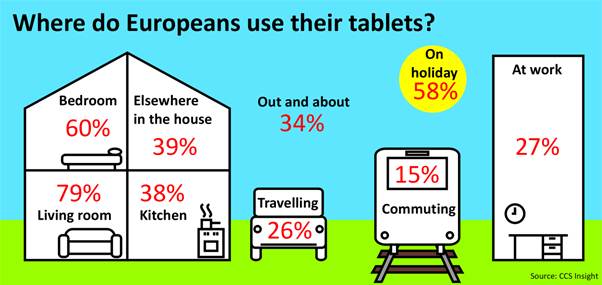Survey probes iPad-style tablet use preferences
Last updated Nov 2, 2011 — 451 views A recent survey probed the reasons why consumers buy iPad-style tablets, and where and how the devices are being used. Interestingly, non-iPad users reported 30 minutes more daily tablet use, on average, than iPad users.
A recent survey probed the reasons why consumers buy iPad-style tablets, and where and how the devices are being used. Interestingly, non-iPad users reported 30 minutes more daily tablet use, on average, than iPad users.
The CCS Insight tablet user survey, conducted in August, analyzed data from 4,500 users of Apple and non-Apple tablets in six European countries.
According to the market analyst firm, iPad-style tablets have begun displacing laptops and netbooks around the home and on the go. A key factor in this trend is that the devices let their users participate in family activities while simultaneously maintaining online connections.
Other noteworthy findings from the survey include…
- Livingrooms, bedrooms, and kitchens are the main locations of use (see infographic below)
- More than half bring their tablets on vacations, but just 15 percent use them during commutes
- Over 90 percent use their tablets for an hour or more each day, with UK users reporting the heaviest use: 2.8 hrs
- Younger people are more likely to own the less costly non-Apple devices
- Business users won’t engage with tablets until there are “vast improvements” in enterprise apps

Where iPad-style users use their tablets
CCS Insight’s complete overview of its recent Tablet User Survey appears below.
Sofa Surfers and Bedroom Browsers are the early adopters in the tablet market as consumers substitute laptops and netbooks for lighter, more portable devices they can use around the home.
Almost 80 percent of the total 4,500 respondents to our survey said they’re using their tablets in the living room. In the UK and France, nearly seven in ten use it in the bedroom, while almost four in 10 Europeans log-on in the kitchen.
“Previously, people had to leave the room and sit down at a computer to use the Internet. A tablet offers a more convenient and social means of access, allowing users to join in with family activities while remaining on-line,” commented Martin Garner, Senior Vice President, Internet, at CCS Insight.
Tablet use on holiday is also popular, with 58 percent of owners packing the device in their suitcase. “The Internet is now so tightly built into many people’s daily lives that they want to continue the connected lifestyle when they take a break from work,” added Garner.
Tablet usage among commuters is surprisingly low — just 15 percent take their tablet when traveling to and from work. We believe that people want to use tablets in this way, but that the cost of 3G tariffs and limited availability of WiFi are encouraging people to opt for e-readers like Amazon’s Kindle instead.
Our survey also showed that only 7 percent of owners use their tablet mainly for work, compared with 60 percent who use it mainly for leisure. “This statistic will alarm tablet-makers that are trying to sell devices to the enterprise market,” said Garner. “Business customers will not engage with tablets until they see a vast improvement in enterprise software on tablets.”
Consumers in the UK are the heaviest users of tablets in the six European markets surveyed, averaging 2.8 hours a day. An overwhelming 95 percent of UK tablet owners use their device for at least an hour a day and 11 percent are online for more than five hours each day, according to the survey.
Interestingly, non-iPad owners are recording an average of 30 minutes more usage a day than people with Apple iconic device. This trend was evident in all markets surveyed. “We found that younger people are more likely to own cheaper non-Apple devices, and that these users tend to be most engaged with social networks,” said Garner.
Further info on the survey
The Tablet User Survey, conducted in August 2011, is CCS Insight’s latest product. It polled 4,500 Apple and non-Apple tablet owners in six European countries (France, Germany, Italy, Netherlands, Spain, and the UK). The survey, which “covers all aspects of tablet usage and purchasing behavior,” according to CCS Insight, is available in the form of a PowerPoint report and a presentation of findings to clients. It is updated twice a year. For more information visit the market analyst firm’s website.